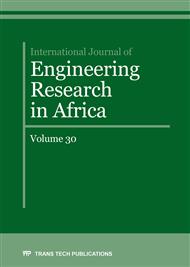[1]
A. Baker, Bonded composite repair of fatigue-cracked primary aircraft structure, Compos. Struct. 47(1) (1999) 431-443.
DOI: 10.1016/s0263-8223(00)00011-8
Google Scholar
[2]
A. A. Baker, Repair of cracked or defective metallic aircraft components with advanced fiber composites—an overview of Australian work, Compos. Struct. 2(2) (1984) 153-181.
DOI: 10.1016/0263-8223(84)90025-4
Google Scholar
[3]
C. Soutis, F. Z. Hu, Design and performance of bonded patch repairs of composite structures, Proceedings of the Institution of Mechanical Engineers, Part G: J. Aerospace. Eng. 211(4) (1997) 263-271.
DOI: 10.1243/0954410971532668
Google Scholar
[4]
H. Jian-Bin, L. Xu-Dong, M. Zhi-Tao, Fatigue behavior of thick center cracked aluminum plates repaired by two-sided composite patching, Mater. Design. 88 (2015) 331-335.
DOI: 10.1016/j.matdes.2015.09.011
Google Scholar
[5]
H. Fekirini, B. Bachir Bouiadjra, M. Belhouari, B. Boutabout, B. Serier, Numerical analysis of the performances of bonded composite repair with two adhesive bands in aircraft structures, Compos. Struct. 82(1) (2008) 84-89.
DOI: 10.1016/j.compstruct.2006.12.004
Google Scholar
[6]
B. Bachir Bouiadjra, M. Belhouari, B. Serier, Computation of the stress intensity factors for repaired cracks with bonded composite patch in mode I and mixed mode, Compos. Struct. 56(4) (2002) 401-406.
DOI: 10.1016/s0263-8223(02)00023-5
Google Scholar
[7]
B. Bachir Bouiadjra, F. Benyahia, , A. Albedah, , B. A. B. Bouiadjra, S. M. Khan, Comparison between composite and metallic patches for repairing aircraft structures of aluminum alloy 7075 T6, Int. J. Fatigue, 80 (2015) 128-135.
DOI: 10.1016/j.ijfatigue.2015.05.018
Google Scholar
[8]
M. Ramji, R. Srilakshmi, M. B. Prakash, Towards optimization of patch shape on the performance of bonded composite repair using FEM, Compos. Part B-Eng. 45(1) (2013) 710-720.
DOI: 10.1016/j.compositesb.2012.07.049
Google Scholar
[9]
R. Brighenti, Patch repair design optimisation for fracture and fatigue improvements of cracked plates, Int. J. Solids. Struct. 44(3) (2007) 1115-1131.
DOI: 10.1016/j.ijsolstr.2006.06.006
Google Scholar
[10]
H. Errouane, Z. Sereir, A. Chateauneuf, Numerical model for optimal design of composite patch repair of cracked aluminum plates under tension. Int. J. Adhes. Adhes. 49 (2014) 64-72.
DOI: 10.1016/j.ijadhadh.2013.12.004
Google Scholar
[11]
X. J. Gong, P. Cheng, S. Aivazzadeh, X. Xiao, Design and optimization of bonded patch repairs of laminated composite structures, Compos. Struct. 123 (2015) 292-300.
DOI: 10.1016/j.compstruct.2014.12.048
Google Scholar
[12]
D. Ouinas, B. Bachir Bouiadjra, B. Achour, N. Benderdouche, Modelling of a cracked aluminium plate repaired with composite octagonal patch in mode I and mixed mode, Mater. Design. 30(3) (2009) 590-595.
DOI: 10.1016/j.matdes.2008.05.040
Google Scholar
[13]
T. Achour, B. Bachir Bouiadjra, B. Serier, Numerical analysis of the performances of the bonded composite patch for reducing stress concentration and repairing cracks at notch, Comp. Mater. Sci. 28(1) (2003) 41-48.
DOI: 10.1016/s0927-0256(03)00054-5
Google Scholar
[14]
X. Liu, G. Wang, Progressive failure analysis of bonded composite repairs, Compos. Struct. 81(3) (2007) 331-340.
DOI: 10.1016/j.compstruct.2006.08.024
Google Scholar
[15]
C. H. Chue, L. C. Chang, J. S. Tsai, Bonded repair of a plate with inclined central crack under biaxial loading, Compos. Struct. 28(1) (1994) 39-45.
DOI: 10.1016/0263-8223(94)90004-3
Google Scholar
[16]
A. Megueni, B. Bachir Bouiadjra, B. Boutabout, Computation of the stress intensity factor for patched crack with bonded composite repair in pure mode II, Compos. Struct. 59(3) (2003) 415-418.
DOI: 10.1016/s0263-8223(02)00285-4
Google Scholar
[17]
T. F. Christian, D. O. Hammond, J. B. Cochran, Composite material repairs to metallic airframe components, J. Aircraft. 29(3) (1992) 470-476.
DOI: 10.2514/3.46185
Google Scholar
[18]
T. V. Umamaheswar, R. Singh, Modelling of a patch repair to a thin cracked sheet, Eng. Fract. Mech. 62(2) (1999) 267-289.
DOI: 10.1016/s0013-7944(98)00088-5
Google Scholar
[19]
M. R. Ayatollahi, R. Hashemi, Computation of stress intensity factors (K I, K II) and T-stress for cracks reinforced by composite patching, Compos. Struct. 78(4) (2007) 602-609.
DOI: 10.1016/j.compstruct.2005.11.024
Google Scholar
[20]
J. J. Schubbe, S. Mall, Fatigue behavior in thick aluminum panels with a composite repair, In Procedings of SDM/AIAA Conference. (1998) 2434-2443.
DOI: 10.2514/6.1998-1997
Google Scholar
[21]
A. A. Baker, Repair efficiency in fatigue‐cracked aluminium components reinforced with boron/epoxy patches, Fatigue. Fract. Eng. M. 16(7) (1993) 753-765.
DOI: 10.1111/j.1460-2695.1993.tb00117.x
Google Scholar
[22]
D. Ouinas, B. Bachir Bouiadjra, B. Serier, The effects of disbonds on the stress intensity factor of aluminium panels repaired using composite materials, Compos. struct. 78(2) (2007) 278-284.
DOI: 10.1016/j.compstruct.2005.10.012
Google Scholar
[23]
R.J. Callinan, L.R.F. Rose, C.H. Wang, Three dimensional stress analysis of crack patching, in: Proceedings of international Conference on Fracture, ICF-9 (1997) 2151–2158.
Google Scholar
[24]
Y. W. Kwon, B. L. Hall, Analyses of cracks in thick stiffened plates repaired with single-sided composite patch, Compos. Struct. 119 (2015) 727-737.
DOI: 10.1016/j.compstruct.2014.09.052
Google Scholar
[25]
H. Hosseini-Toudeshky, B. Mohammadi, H. R. Daghyani, Mixed-mode fracture analysis of aluminium repaired panels using composite patches, Compos. Sci. Technol. 66(2) (2006) 188-198.
DOI: 10.1016/j.compscitech.2005.04.028
Google Scholar
[26]
H. Hosseini-Toudeshky, G. Sadeghi, H. R. Daghyani, Experimental fatigue crack growth and crack-front shape analysis of asymmetric repaired aluminium panels with glass/epoxy composite patches, Compos. Struct. 71(3) (2005) 401-406.
DOI: 10.1016/j.compstruct.2005.09.032
Google Scholar
[27]
D. C. Seo, J. J. Lee, Fatigue crack growth behavior of cracked aluminum plate repaired with composite patch, Compos. Struct. 57(1) (2002) 323-330.
DOI: 10.1016/s0263-8223(02)00095-8
Google Scholar
[28]
W. Y. Lee, J. J. Lee, Successive 3D FE analysis technique for characterization of fatigue crack growth behavior in composite-repaired aluminum plate, Compos. Struct. 66(1) (2004) 513-520.
DOI: 10.1016/j.compstruct.2004.04.074
Google Scholar
[29]
J. Aakkula, O. Saarela, An experimental study on the fatigue performance of CFRP and BFRP repaired aluminium plates, Compos. Struct. 118 (2014) 589-599.
DOI: 10.1016/j.compstruct.2014.07.050
Google Scholar
[30]
G. C. Sih, Handbook of stress-intensity factors. Lehigh University, Institute of Fracture and Solid Mechanics. (1973).
Google Scholar


